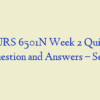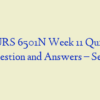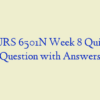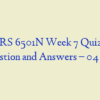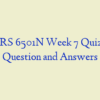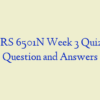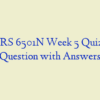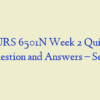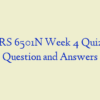Description
NURS 6501N Week 3 Quiz – Advanced Pathophysiology (25 out of 25 points)
- A 60-year-old female with a recent history of head trauma and long-term history of hypertension presents to the ER for changes in mental status. MRI reveals that she had a hemorrhagic stroke. What does the nurse suspect caused this type of stroke?
- A 40-year-old male complains of uncontrolled excessive movement and progressive dysfunction of intellectual and thought processes. He is experiencing movement problems that begin in the face and arms that eventually affect the entire body. The most likely diagnosis is:
- A 15-month-old child from Pennsylvania was brought to the ER for fever, seizure activity, cranial palsies, and paralysis. Which of the following diagnosis will be documented in the chart?
- When a patient has a peculiar sensation that immediately precedes a seizure, what term should the nurse use to describe this sensation?
- A 15-year-old male was struck by a motor vehicle and suffered a traumatic brain injury. Paramedics found him unconscious at the scene of the accident. During the ambulance ride, he regained consciousness and was able to maintain a conversation with the medical staff. Upon arrival to the hospital, he was alert and oriented. Physical exam reveals confusion and impaired responsiveness. What is the probable nature of his brain injury based on this history?
- A 75-year-old female suffers a stroke and now has difficulty writing and production of language. This condition is most likely caused by occlusion of the: nurs 6501n week 3
- A 69-year-old male with a history of alcohol abuse presents to the emergency room (ER) after a month-long episode of headaches and confusion. Based on his alcoholism, a likely cause of his neurologic symptoms is:
- Which system modulates a patient’s perception of pain?
- Which finding indicates the patient is having complications from heat stroke?
- A nurse thinks a patient may be experiencing dementia. Which assessment finding will most help support this diagnosis?
- A child presents to his primary care provider with disorientation, delirium, aggressiveness, and stupor. His parents report that he was recently ill with an upper respiratory infection, which they treated with aspirin. Which of the following is the most likely diagnosis?
- A patient with an addiction to alcohol checked into a rehabilitation center. He experiences delirium, inability to concentrate, and is easily distracted. From which of the following is he most likely suffering?
- A patient has memory loss of events that occurred before a head injury. What cognitive disorder does the nurse suspect the patient is experiencing?
- An initial assessment finding associated with acute spinal cord injury is _____ the injury.
- The nursing student would correctly identify the most common symptom of brain abscess as:
- A nurse should document on the chart that chronic pain is occurring when the patient reports the pain has lasted longer than:
- Parents of a 3-month-old infant bring him to the emergency room (ER) after he has had a seizure. He has muscle rigidity, and the parents report they are of Jewish ancestry. For what genetic disease should this infant be screened?
- A teenage boy sustains a severe closed head injury following an all-terrain vehicle (ATV) accident. He is in a state of deep sleep that requires vigorous stimulation to elicit eye-opening. How should the nurse document this in the chart?
- A 20-year-old male was at the supermarket when he fell to the ground. Bystanders reported that he lost consciousness and his body tensed up then relaxed, then tensed and relaxed several times. He most likely was experiencing a(n):
- A 23-year-old female begins having problems with tiredness, weakness, and visual changes. Her diagnosis is multiple sclerosis (MS). What is occurring in the patient’s body? nurs 6501n week 3
- A 30-year-old female had a seizure that started with her fingers and progressively spread up her arm and then extended to her leg, with no loss of consciousness. How should the nurse chart this?
- A 50-year-old male suffers a severe head injury when his motorcycle hits a tree. His breathing becomes deep and rapid but with a normal pattern. What term should the nurse use for this condition?
- A 72-year-old male demonstrates left-sided weakness of upper and lower extremities. The symptoms lasted 24 hours and resolve with no evidence of infarction. The patient most likely experienced a(n):
- A 20-year-old male was brought to the emergency room (ER) for severe burns. He requested something for the excruciating pain he was experiencing. Blocking which of the following neurotransmitters would reduce his pain?
- When a patient has a fever, which of the following thermoregulatory mechanisms is activated?



